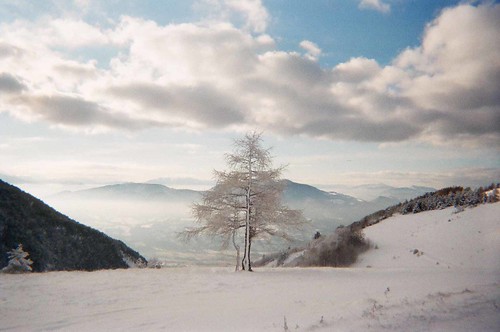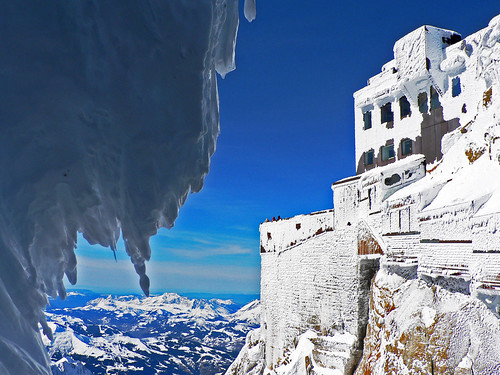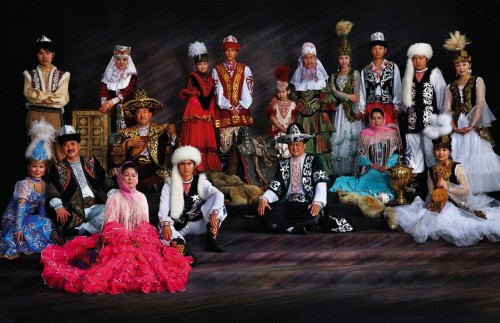The hump is over. We've just (depending on where in the Northern hemisphere you live) had our shortest day and our longest night, while the sun's maximum position in the sky is at is lowest. From now on the days get longer. Unless you're Australian.
"Solstice" is derived from the Latin phrase for "sun stands still." In the bad old days, the winter solstice was hugely important because winter could be so hard - the time between January and April was also known as the famine months.
Being the shortest day of the year, the winter solstice is essentially the year's darkest day, but it's not the coldest. Because the oceans are slow to heat and cool, in December they still retain some warmth from summer, delaying the coldest of winter days for another month and a half. Similarly, summer doesn't hit its heat peak until August, a month or two after the summer solstice.
In temperate climates, the midwinter festival was the last feast celebration before deep winter began. Most cattle were slaughtered so they would not have to be fed during the winter, so it was almost the only time of year when a supply of fresh meat was available. The majority of wine and beer made during the year was finally fermented and ready for drinking at this time. Most of these parties started on the previous evening rather than at midnight or dawn.
And because it means the sun is coming back, a lot of it is - especially in cultures using cyclic calendars - is based around birth and rebirth of everything from your god(s) to your own manna and new beginnings (such as Hogmanay's redding, a New Year cleaning tradition). In Greek mythology, the gods and goddesses met on the winter and summer solstice, and Hades was permitted on Mount Olympus. It was also a time to celebrate reversal between slave and master - for example in Rome's Saturnalia, the lord of the house would wait on the servants, schools were closed, the army rested and no criminals were executed.
Around 350 AD, December 25 was adopted in Rome and gradually almost the entire Christian Church agreed to that date, which coincided with Winter Solstice, the Yule (same thing) and the Saturnalia. The merry side of Saturnalia was adopted to the observance of Christmas. By 1100 Christmas was the peak celebration of the year for all of Europe. During the 16th century, under the influence of the Reformation, many of the old customs were suppressed and the Church forbade processions, colourful ceremonies, and plays.
In 1647 in England, Parliament passed a law abolishing Christmas altogether. When Charles II came to the throne, many of the customs were revived, but the feasting and merrymaking were now more worldly than religious.
Our Midwinter festivals fight of the darkness and welcome light, often calling for evergreens, bright illumination, big-ass fires, feasting, communion with close ones, and lots of running around dancing and singing - a sort of group therapy against Seasonal Affective Disorder.
Here are some cut and pastings:
Japan
In late seventh century Japan, festivities were held to celebrate the reemergence of Amaterasu or Amateras, the sun goddess of Japanese mythology, from her seclusion in a cave. Tricked by the other gods with a loud celebration, she peeks out to look and finds the image of herself in a mirror and is convinced by the other gods to return, bringing sunlight back to the universe. Requiems for the dead were held and Manzai and Shishimai were performed throughout the night, awaiting the sunrise. Aspects of this tradition have continued to this day on New Years.
Sami people
The Saami, indigenous people of Finland, Sweden and Norway, worship Beiwe, the sun-goddess of fertility and sanity. She travels through the sky in a structure made of reindeer bones with her daughter, Beiwe-Neia, to herald back the greenery on which the reindeer feed. On the winter solstice, her worshipers sacrifice white female animals, and with the meat, thread and sticks, bed into rings with ribbons. They also cover their doorposts with butter so Beiwe can eat it and begin her journey once again.
Buddhist(?)
The Winter Solstice Festival or The Extreme of Winter (Chinese and Japanese: 冬至; Korean: 동지; Vietnamese: Đông chí) (Pinyin: Dōng zhì), (Rōmaji: Tōji), (Romaja:Dongji) is one of the most important festivals celebrated by the Chinese and other East Asians during the dongzhi solar term on or around December 21 when sunshine is weakest and daylight shortest; i.e., on the first day of the dongzhi solar term. The origins of this festival can be traced back to the yin and yang philosophy of balance and harmony in the cosmos. After this celebration, there will be days with longer daylight hours and therefore an increase in positive energy flowing in. The philosophical significance of this is symbolized by the I Ching hexagram fù (復, "Returning"). Traditionally, the Dongzhi Festival is also a time for the family to get together. One activity that occurs during these get togethers (especially in the southern parts of China and in Chinese communities overseas) is the making and eating of Tangyuan (湯圓, as pronounced in Cantonese; Mandarin Pinyin: Tāng Yuán) or balls of glutinous rice, which symbolize reunion. In Korea, similar balls of glutinous rice (Korean: 새알심) (English pronunciation:Saealsim), is prepared in a traditional porridge made with sweet red bean (Korean: 팥죽)(English pronunciation:Patjook). Patjook was believed to have a special power and sprayed around houses on winter solstice to repel sinister spirits. This practice was based on a traditional folk tale, in which the ghost of a man that used to hate patjook comes haunting innocent villagers on the winter solstice.
Scotland
The New Years Eve celebration of Scotland is called Hogmanay. The name derives from the old Scots name for Yule gifts of the Middle Ages. The early Hogmanay celebrations were originally brought to Scotland by the invading and occupying Norse who celebrated a solstitial new year (England celebrated the new year on March 25). In 1600, with the Scottish application of the January 1 New year and the church's persistent suppression of the solstice celebrations, the holiday traditions moved to December 31. The festival is still referred to as the Yules by the Scots of the Shetland Islands who start the festival on December 18 and hold the last tradition (a Troll chasing ritual) on January 18. The most widespread Scottish custom is the practice of first-footing which starts immediately after midnight on New Years. This involves being the first person (usually tall and dark haired) to cross the threshold of a friend or neighbor and often involves the giving of symbolic gifts such as salt (less common today), coal, shortbread, whisky, and black bun (a fruit pudding) intended to bring different kinds of luck to the householder. Food and drink (as the gifts, and often Flies cemetery) are then given to the guests.
Jamaica
Junkanoo, in The Bahamas, Junkunno or Jonkanoo, in Jamaica, is a fantastic masquerade, parade and street festival, suspected to be derived from Dzon'ku 'Nu (tr: Witch-doctor) of the West African Papaws, an Ewe people.[18] It is traditionally performed through the streets towards the end of December, and involves participants dressed in a variety of fanciful costumes, such as the Cow Head, the Hobby Horse, the Wild Indian, and the Devil. The parades are accompanied by bands usually consisting of fifes, drums, and coconut graters used as scrapers, and Jonkanoo songs are also sung. A similar practice was once common in coastal North Carolina, where it was called John Canoe, John Koonah, or John Kooner. John Canoe was likened to the wassailing tradition of medieval Britain. John Canoe was interpreted by many Euro-Americans to bear strong resemblance to the social inversion rituals that marked the ancient Roman celebration of Saturnalia.
Slavic
Karachun, Korochun or Kračún was a Slavic holiday similar to Halloween as a day when the Black God and other evil spirits were most potent. It was celebrated by Slavs on the longest night of the year. On this night, Hors, symbolising the old sun, becomes smaller as the days become shorter in the Northern Hemisphere, and dies on December 22nd, the December solstice. He is said to be defeated by the dark and evil powers of the Black God. In honour of Hors, the Slavs danced a ritual chain-dance which was called the horo. Traditional chain-dancing in Bulgaria is still called horo. In Russia and Ukraine, it is known as khorovod. On December 23rd Hors is resurrected and becomes the new sun, Koleda. On this day, Western Slavs burned fires at cemeteries to keep their departed loved ones warm, organized dinings in the honor of the dead so as they would not suffer from hunger and lit wooden logs at local crossroads.
Lenaea
In the Aegean civilizations, the exclusively female midwinter ritual, Lenaea or Lenaia, was the Festival of the Wild Women. In the forest, a man or bull representing the god Dionysus was torn to pieces and eaten by Maenads. Later in the ritual a baby, representing Dionysus reborn, was presented. Lenaion, the first month of the Delian calendar, derived its name from the festival's name. By classical times, the human sacrifice had been replaced by that of a goat, and the women's role had changed to that of funeral mourners and observers of the birth. Wine miracles were performed by the priests, in which priests would seal water or juice in a room overnight and the next day they would have turned into wine. The miracle was said to have been performed by Dionysus and the Lenaians. By the 5th century BC the ritual had become a Gamelion festival for theatrical competitions, often held in Athens in the Lenaion theater.
India and Nepal/Hindu
Makara Sankranti, celebrated at the beginning of Uttarayana, is the only Hindu festival which is based on the celestial calendar rather than the lunar calendar. The zodiac having drifted from the solar calendar has caused the festival to now occur in mid-January (see precession of equinoxes). In Tamil Nadu it is celebrated as the festival of Pongal. The day before Pongal, the last day of the previous year, they celebrate Bhogi. In Assam it is called Magh Bihu (the First day of Magh), in Punjab Lohri and in Hindi speaking states and Maharshtra it is observed as Makar Sankranti and is celebrated by exchanging balls of sesame candy (Til Gur) and requesting each other to be as sweet as the candy balls for the next year. It is called Makara Sankrant because the sun enters the zodiacal sign of Capricorn on 14 January (Makar meaning Capricorn). It is celebrated with much pomp in Andhra Pradesh, where the festival is celebrated for three days and is more of a cultural festival than an auspicious day as in other parts of India. In some parts of India, the festival is celebrated by taking dips in the Ganga or another river and offering water to the Sun god. The dip is said to purify the self and bestow punya. In many states, mainly in Gujarat, families fly bright colorful kites from their roofs all day and into the night. It is a form of celebrating and welcoming the longer days. It is also very common to feed grass to the cows on this day. In Assam on Bihu Eve or Uruka families build house-like structures called bhelaghar and separate large bhelaghar are built by the community as a whole. Different sorts of twine are tied around fruit trees. Traditionally, fuel is stolen for the final ceremony, when all the bhelaghar are burned. Their remains are then placed at the fruit trees. Special puja is offered as a thanksgiving for good harvest. Since the festival is celebrated in midwinter, the foods prepared for this festival are such that they keep the body warm and give high energy.
Perchta ritual (Alps)
Early Germans (c.500–1000) considered the Norse goddess, Hertha or Bertha to be the goddess of light, domesticity and the home. They baked yeast cakes shaped like shoes, which were called Hertha's slippers, and filled with gifts. "During the Winter Solstice houses were decked with fir and evergreens to welcome her coming. When the family and serfs were gathered to dine, a great altar of flat stones was erected and here a fire of fir boughs was laid. Hertha descended through the smoke, guiding those who were wise in saga lore to foretell the fortunes of those persons at the feast". There are also darker versions of Perchta which terrorize children along with Krampus.[youtube=http://www.youtube.com/watch?v=6tABfctNaSI&color1=0xb1b1b1&color2=0xcfcfcf&hl=en_US&feature=player_embedded&fs=1]




























